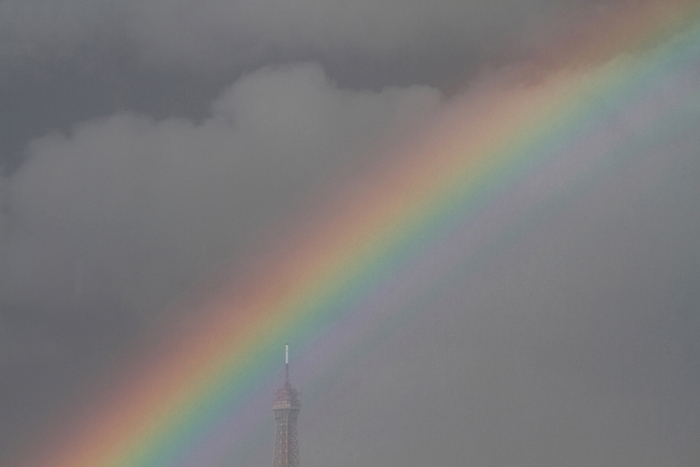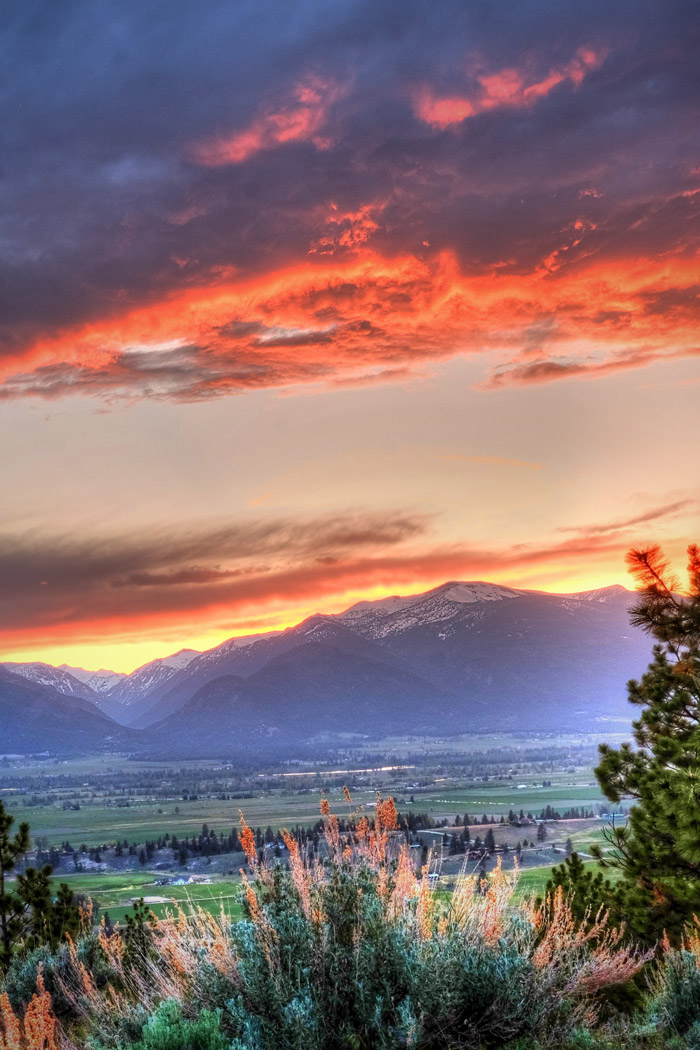Hole in the Clouds
Feb 13, 2010

Monarch butterflies know how to enjoy winter; they fly south, leaving the eastern United States and heading for the mountains around Tlalpujahua, in the state of Michoacan, Mexico. Winter nights can get chilly up there in the mountains, and the butterflies huddle together in the trees. But the days are warm and sunny, and every morning as the temperature approaches 70 degrees, the Monarchs take to the air, flocking skyward all at once.
No single Monarch lives long enough to migrate to Mexico in the fall and back to the States in the spring. But somehow, the young butterflies born in Mexico each winter know to start flying north in March, and even know to head for particular ancestral summer homes, which they've never seen before. There, they mate and produce a new generation, which is born not only with the magic power to change from caterpillars into pupae into butterflies but also with the knowledge of when to head south in the fall and how to find the Mexican mountaintop where their ancestors always liked to spend the winter.
animals
butterflies
sky
(Image credit: Woody Campbell)
Oct 26, 2010

Looks like he's almost finished.
cityscape
sky
(Image credit: Sam Javanrouh)
Sep 9, 2011
 Way, way out in the country, a million miles away from city lights, on a clear night the sky is lit by stars, as we see above at left, in a photo taken in Glacier National Park in Montana. The few small clouds in this starlit sky show up as black blotches that block some of the stars; a completely cloudy night in remote parts of the world is a very, very dark night, too dark to photograph at all.
Way, way out in the country, a million miles away from city lights, on a clear night the sky is lit by stars, as we see above at left, in a photo taken in Glacier National Park in Montana. The few small clouds in this starlit sky show up as black blotches that block some of the stars; a completely cloudy night in remote parts of the world is a very, very dark night, too dark to photograph at all.
In the megalopolis, however, clouds actually light up the sky by reflecting urban light pollution to brighten the night dramatically; an overcast night in a big city like Berlin, shown above at right, can be up to ten times brighter than a clear night.
Germany
birdseye view
night
Berlin
sky
clouds
Montana
Glacier National Park
(Image credits: Ray Stinson [L] and Christopher Kyba [R via NASA])
Nov 16, 2011
 That's the Eiffel Tower under all that sky, late in the afternoon of October 25, 2011.
That's the Eiffel Tower under all that sky, late in the afternoon of October 25, 2011.
cityscape
weather
Paris
sky
France
rainbow
(Image credit: Bertrand Kulik, Earth Science Picture of the Day)
Jun 26, 2013
 Over the red roof. At the Red Roof Inn outside Boston, near Logan Airport.
Over the red roof. At the Red Roof Inn outside Boston, near Logan Airport.
Boston
weather
sky
rainbow
Red Roof Inn
(Image credit: John Stein)
Jul 15, 2013
 Looking out over Philadelphia through the window of a restaurant on the 37th floor of 2 Liberty Place, a downtown skyscraper.
Looking out over Philadelphia through the window of a restaurant on the 37th floor of 2 Liberty Place, a downtown skyscraper.
cityscape
birdseye view
night
sunset
Philadelphia
sky
skyline
skyscrapers
Center City
Sep 2, 2013
 Japan's Mount Fuji, just before dawn.
Japan's Mount Fuji, just before dawn.
This is a pretty spectacular photo, with the features of an iconic landscape dwarfed by a skyful of stars and clouds and hints of daylight. Modern cameras can capture this sort of scene more or less routinely if they are set up to stare into the night, lens wide open, without blinking or moving for, in this case, twenty seconds.
The human eye could drink it in at a glance, if only we were there. But we weren't there, sadly. This morning, we must make do with the picture, and fortunately it's a picture that rewards a slowly wandering eye with pleasant little discoveries in the realms of shadow and glow, detail and hulk, pattern and emptiness.
landscape
night
Japan
dawn
sky
mountain
stars
Mount Fuji
(Image credit: Hayato Ebihara)
Nov 27, 2013
 The cold and the storms both showed up in Philadelphia this week, but somehow the effect we see here in a high mountain valley in the Tyrolean Alps is a little more dramatic and astonishing than it is out on the streets and sidewalks of Brotherly Love. Pretty much all we've got in town right now are slashing rains and chill.
The cold and the storms both showed up in Philadelphia this week, but somehow the effect we see here in a high mountain valley in the Tyrolean Alps is a little more dramatic and astonishing than it is out on the streets and sidewalks of Brotherly Love. Pretty much all we've got in town right now are slashing rains and chill.
landscape
mountains
winter
Italy
snow
sky
clouds
storm
South Tyrol
Dec 24, 2013
 We saw more rainbows in two weeks in the skies over New Zealand than we might expect to glimpse in two years in the States. Here's a sampling: above, in Queenstown on the South Island, and below, looking toward Wellington from Eastbourne on the North Island.
We saw more rainbows in two weeks in the skies over New Zealand than we might expect to glimpse in two years in the States. Here's a sampling: above, in Queenstown on the South Island, and below, looking toward Wellington from Eastbourne on the North Island.

New Zealand
sky
skyscape
Queenstown
Eastbourne
rainbows
(Image credits: Little Fuji, Little iPhone)
Feb 8, 2014
 Conceded: the sun was already below the horizon when it did all this to the sky the other day. Say it set ten or fifteen minutes earlier, around 5:30 PM.
Conceded: the sun was already below the horizon when it did all this to the sky the other day. Say it set ten or fifteen minutes earlier, around 5:30 PM.
5:30's not bad. Really. We don't have to pay any attention to that groundhog behind the curtain: spring is coming.
Still have to wear a coat, though.. . .
sunset
Bethesda
sky
trees
MD
(Image credit: Little Fuji)
May 31, 2014

landscape
sunset
sky
Montana
Stevensville
Bitterroot Valley
(Image credit: Little Fuji)
Jun 3, 2014
 This is the time of year when, in many places, the first springtime crop of mosquitoes takes to the air at once and . . . swarms.
This is the time of year when, in many places, the first springtime crop of mosquitoes takes to the air at once and . . . swarms.
The Alaskan tundra and other Arctic-like regions are notorious for huge dark clouds of skeeters, hovering hungrily and buzzing, whining--call it screaming for blood.
But this photo was taken last week in Portugal, in the salt marshes near Vila Franca de Xira. The swarm affected the shape of a tornado, and perhaps inspired a bit of the fear associated with tornadoes. But it wasn't really a cyclone; the flight pattern of the little bloodsuckers wasn't rotational, just the usual brownian motion within the overall swarm. And the top of the swarm was much closer to the viewer than the bottom, which is why it appears wider.
We are told that outside of the tropics, people don't really die from mosquito bites, even if they get hundreds of bites, as in a serious swarm. They don't die; they just wish they would.
sky
seascape
Portugal
insects
tornado
ocean
marshes
cyclone
mosquitoes
Vila Franca de Xira
(Image credit: Ana Filipa Scarpa)
Jun 11, 2014
 On Monday, the skies over Paris got themselves all tied up in a knot and spit out baseball-to-softball-sized hail across the Ile de France.
On Monday, the skies over Paris got themselves all tied up in a knot and spit out baseball-to-softball-sized hail across the Ile de France.
The supercell wall cloud at the heart of the thunderstorm is shown in this photo snapped by a commercial airline pilot whose jet passed safely by, if a little too close for comfort. The cloud grew so tall it bumped up against the tropopause–essentially, the upper boundary of the atmosphere–where it spread out flat.
This sort of weather is a common summertime phenomenon across the Great Plains in the United States, but it's rare in most other parts of the world. For the past three days, however, France has been enjoying supercell storms in all their magnificence.

sky
France
cloud
storm
supercell
(Image credit: @Nir890)
Jul 16, 2014
 Photographer Artie Leonard snags a shot for the National Photo Company in 1923.
Photographer Artie Leonard snags a shot for the National Photo Company in 1923.
sky
work
photographers
b&w
A. W. Leonard
1923
pole
light pole
telephone pole
wires
(Image credit: National Photo Company, via Shorpy)
Jul 27, 2014

landscape
Spain
night
sunset
sky
church
stars
(Image credit: Juan Jose Ferres)
Dec 22, 2014
 Finally, the rains have come back to California. Recently, as the sun was going down over Los Angeles, a downpour was letting up.
Finally, the rains have come back to California. Recently, as the sun was going down over Los Angeles, a downpour was letting up.
cityscape
sunset
California
sky
skyline
clouds
Los Angeles
drought
rain
(Image credit: Lectrolink)
Dec 29, 2014
 The only skyscraper in the city of Washington, as glimpsed from Arlington National Cemetery.
The only skyscraper in the city of Washington, as glimpsed from Arlington National Cemetery.
Washington
winter
sky
skyline
clouds
Washington Monument
Arlington National Cemetery
D.C.
(Image credit: Fuji T)
Jan 23, 2015
 Waikiki
Waikiki
beach
cityscape
sunset
sky
skyline
palm trees
Hawaii
Honolulu
(Image credit: Little Fuji)












 This is the time of year when, in many places, the first springtime crop of mosquitoes takes to the air at once and . . . swarms.
This is the time of year when, in many places, the first springtime crop of mosquitoes takes to the air at once and . . . swarms.





